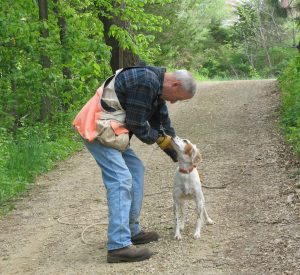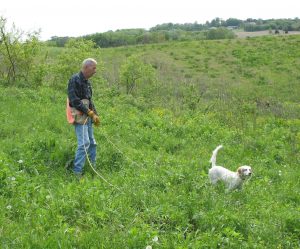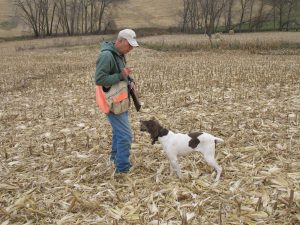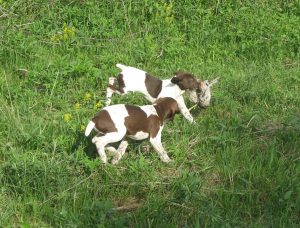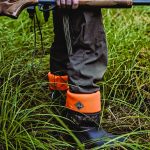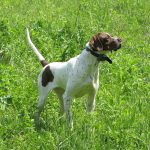POINTING DOG POINTERS: The Late Bloomer
By Bob and Jody Iler
Liz, a liver roan German shorthair pup, came into our kennel for training at six months of age. Though she had a great pedigree and was out of field champions and superb hunting dogs, we were surprised how talented this little pup was! Right from the start, she pointed staunchly, showed enthusiasm for hunting, sought out birdy objectives, and retrieved naturally. She handled gun developed with no problem. Liz was every dog trainer’s dream – a pup with great natural ability that seemed to train herself!
But what about the late bloomer – the young pointing dog that just doesn’t seem to tick off all the boxes – one that shows little interest in hunting, has a soft point or no point at all, or doesn’t want to retrieve? Maybe this dog also shows a little fear or timidity.
If all the dogs we’ve trained over the years were like Liz, we’d likely never have learned as much as we have. For every Liz that came in, there were several others who took much longer to “turn on” and demonstrate all the abilities we look for in a classy pointing dog. Each challenge taught us something new about training pointing dogs.
Late bloomers are generally just slow maturing dogs. But some dogs that seem like late bloomers are inhibited in their development due to other reasons. Perhaps their genetics play a role, and they just did not inherit the prey drive necessary for “the eye of the tiger.” Maybe they have had too much training or pressure put on them too soon, before they were ready for it. This can hinder their growth and zest for hunting, turning them off of birds.
Below are some issues demonstrated by late bloomers for you to consider.
Not Birdy
Pups that don’t seem to be birdy or don’t develop an interest in birds as time progresses may have had an improper introduction to birds. They may be fearful and avoid the birds entirely (blinking), or they may not have an inherent prey drive. If the latter is the case, our prospects don’t look too good – we must have the material there to work with. If it’s the former, we’ve outlined the process we used for a pup that was blinking in our recent column, Blinking – Is There a Cure?
Begin with gentle re-introduction to gamebirds, starting with quail and moving on to larger birds as pup progresses. Have short, fun sessions in the field, allowing pup to chase, catch, and have fun. Don’t overdo it! A couple of birds and a successful session will do more to excite a young dog than repeated, overlong drills that take the fun out of it. Don’t set a timetable. We had a young shorthair that took months to finally turn on to quail – though this is not normally the case, if we had given up on this dog, his owner would not have enjoyed many great years with him.
Not Pointing
We really don’t worry about the point of a young dog initially. We want them to become birdy as all get out. We want them to hunt with drive and abandon. We want them to chase birds. We want them to be outlaws at first! Once they have become a bird-crazy pointing dog, we can worry about all the rest. If a pup has the point in him, don’t worry, it will come out! Working that pup on wild birds will hasten the process too. There are a few dogs that just do not point but continue to jump in and bust birds. Here too, wild birds can help instill caution in them, and they may start to point.
Not Retrieving
Though some pups love to retrieve, there are many that don’t. Or they may love to retrieve dummies but show no interest in picking up a bird. We don’t recommend teaching a young dog the trained retrieve (often known as force-breaking); we prefer to wait at least one hunting season before doing this type of training.
If our young dog has tremendous drive and hunt and loves birds, we want to be very careful not to take this away with a trained retrieve program. It puts a lot of pressure on young dogs, and isn’t really recommended for very soft types, although we’ve had success with some.
One interesting fact that we’ve learned is that if you give a dog time, he may just come around to retrieving on his own! This happened with two of our own personal dogs. Lots of birds, patience, sweet talk, and a few hunting seasons worked their magic!
Gun Issues
If a young dog doesn’t handle the sound of a gun, this is a red flag and indicates that the dog has not been properly developed, step by step, to the gun. In this case, he won’t be a late bloomer, but rather the problem will get worse and he may quit hunting entirely. It’s crucial to introduce pup to noise and gunfire in small, gentle stages – starting with clapping blocks while he is chasing a bird, and graduating slowly through a progression of guns ranging from the popgun to, finally, the shotgun.
In all of these stages, the pup’s focus should always be on the birds, with the sound of the gun a distance away. The pup should always be working the bird that is shot, and never more than a couple shots should be fired at a bird when the young dog is starting out.
We’ve known folks over the years who’ve lucked out with having a “natural dog” like Liz – one that they could hardly make a mistake with. And if your pup is a natural too, that’s great! But for all the rest of our pointing dog pups, we need to take plenty of time to give them the proper training appropriate to their age and temperament. We need to forget about set schedules and timetables. We need to let them be pups for a good long while.
We need to give them the chance to be a late bloomer!
Pointing Dog Pointers features monthly training tips by Bob and Jody Iler, who own Green Valley Kennels in Dubuque, Iowa. Bob and Jody have trained pointing dogs for over 35 years and have written many articles for Pointing Dog Journal.



